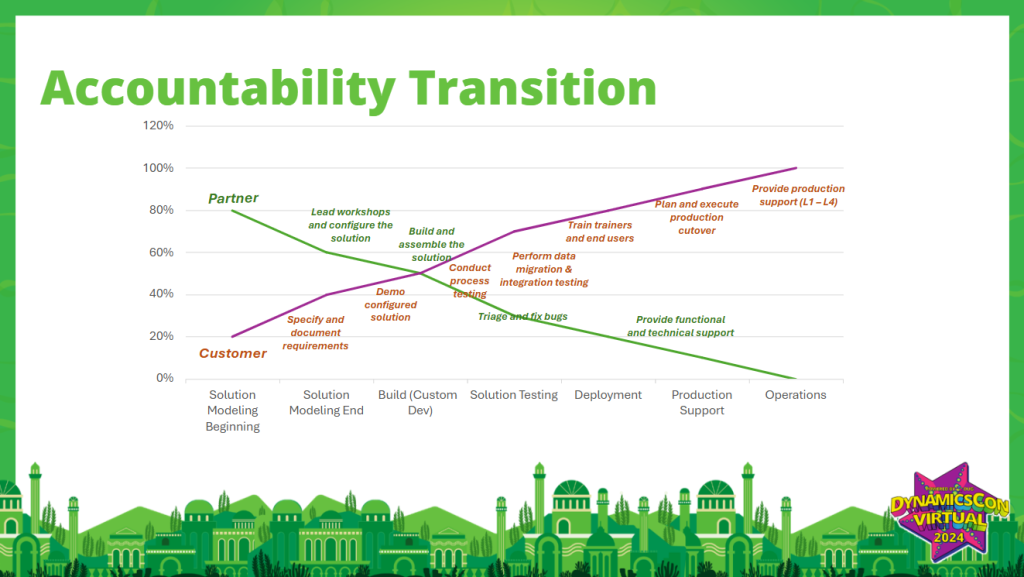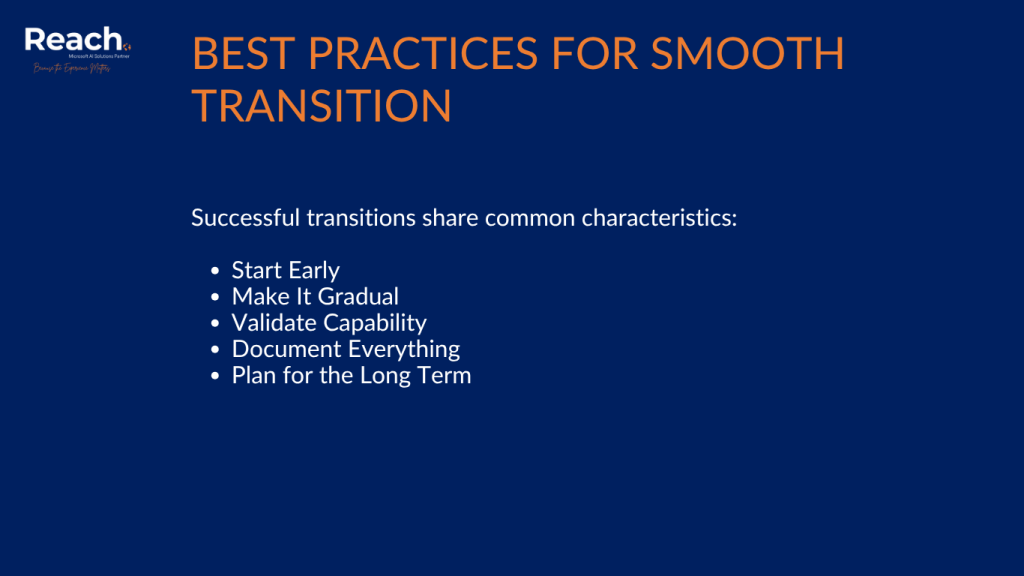This is the seventh and final installment in our series exploring key insights on implementation methodologies for Microsoft Dynamics 365.
The Critical Transition: From Project to Operations
Successful Dynamics 365 implementations don’t end at go-live—they transition smoothly into sustainable operations. “How do we transition this system to the dynamics 365 client? How do we actually make sure that the client takes full ownership?”
The statistics shared paint a sobering picture: with ERP failure rates between 65-80%, many projects that technically “succeed” at go-live ultimately fail in operations because ownership never properly transfers to the dynamics 365 client organization.
The Ownership Transition Model
There need to be a clear model showing how partner and client ownership should evolve throughout the project lifecycle:
| Phase | Partner Ownership | Client Ownership |
| Discovery | 90% | 10% |
| Solution Design | 70% | 30% |
| Build/Test | 50% | 50% |
| Training/Cutover | 30% | 70% |
| Support/Operations | 10% | 90% |
We outline here how the partner’s role decreases, and the customer role increases over time, using what we called a somewhat extreme example from one of our client engagements.
Discovery Phase (90% Partner / 10% Client)
During initial discovery, partners lead the process with their methodology expertise and industry knowledge. However, if you as a client do not have a solution architect, that’s okay, however it is important to understand what Solution Architect’s role is for your particular project.
Solution Design (70% Partner / 30% Client)
As design progresses, client involvement must increase substantially for subject matter experts and end users early on. If a client can invest their time early on, the design decisions will be much better.
Build/Test (50% Partner / 50% Client)
This phase represents the critical midpoint. We advocate strongly for active client participation: “One of the best practices here is if the team, client’s team is able to demo the solution, you know you’re on the right path.”
Training/Cutover (30% Partner / 70% Client)
By this phase, clients should be driving most activities. Most of the time the client says, ‘Yeah, I probably could do it, but can you do it now and we’ll do it later?’ That is okay, but only for a while.
Support/Operations (10% Partner / 90% Client)
Post-go-live, the client should own day-to-day operations with partners providing only specialized support. Most of the time it’s too much for the client to tackle an ERP initiative on their own, while emphasizing that eventual complete independence is the goal.
Why the Final 20% Determines 80% of Success
Implementations that skimp on the final phases—training, support planning, and ownership transition—generate the most user dissatisfaction and operational failures.
User sentiment often crystallizes during training and early operational phases, when they first experience the system without consultant handholding.
Critical Enablement Components
There are several essential elements for successful ownership transition:
1. Comprehensive Training Program
Training must extend beyond basic system operations to include:
- Business process understanding
- System administration capabilities
- Basic troubleshooting skills
- Report generation and modification
- Integration monitoring
Ideally, we have client SMEs in the system early on. They’re seeing the functionality, they’re taking over certain decisions, and they’re actually demoing the system early on in the process.
2. Documented Support Model
Documentation should include:
- Tiered support levels (L1, L2, L3)
- Escalation procedures
- Response time commitments
- Knowledge base access
- Emergency protocols
3. Knowledge Transfer Process
This includes:
- System architecture documentation
- Configuration decisions and rationale
- Customization documentation
- Integration specifications
- Business process maps
“When we have rollouts that last for two, three years, the business will not stand still.” Change management must address:
- Organizational readiness
- Communication plans
- Resistance management
- Benefits realization tracking
- Continuous improvement processes

Warning Signs of Inadequate Transition Planning
There are several red flags:
- Over-reliance on Partner Resources: “Suite Success is very cost effective. But on the other hand, a partner’s role is only to guide and coach. While that can work… most of the time it’s too much for the client to tackle.”
- Delayed Knowledge Transfer: Starting transition planning only after UAT is too late. We advocate for early engagement: “If you think you internally need to bring somebody up to speed, that might be a great time for somebody to observe, to spend time with that solution architect.”
- Unclear Ownership: “Assumptions are not aligned with what both parties expect to happen, emphasizing the need for explicit documentation of responsibilities.
- Inadequate Testing of Support Processes: Support procedures should be tested before go-live, not discovered through production issues.
The Executive’s Role in Ownership Transition
Successful transitions require executive engagement: “These are great opportunities for these individuals to accomplish some major milestones in their careers.”
Executive responsibilities include:
- Ensuring adequate internal resources are allocated
- Supporting knowledge transfer time investment
- Validating support model sustainability
- Monitoring post-go-live satisfaction metrics
- Authorizing necessary ongoing training

Best Practices for Smooth Transition
Successful transitions share common characteristics:
- Start Early
- Make It Gradual
- Validate Capability
- Document Everything
- Plan for the Long Term
The Bottom Line: Ownership Enables Success
The closing message resonated throughout this blog: successful implementations create sustainable operational capabilities, not just deployed systems. The mentality behind every implementation project should be: “When we get there, that means our careers, our organizations are in a better place.”
The ownership transition isn’t an afterthought—it’s the culmination of everything that came before.
Take Action Today
For executive stakeholders, the message is clear: request a detailed client-side transition plan before UAT begins. This plan should include:
- Comprehensive training schedules
- Documented escalation procedures
- Support model specifications
- Knowledge transfer milestones
- Success metrics and monitoring
Final Thoughts: Partner for Success
Throughout this series, we’ve explored insights on methodology selection, project complexity, Success by Design, best practices, governance, and ownership transition. The common thread is clear: successful Dynamics 365 implementations require more than technical and system expertise—they demand strategic thinking, disciplined execution, and committed partnership.
If you’re navigating a Dynamics 365 rollout or recovery, consider engaging experienced partners who understand both the technology and the transformation journey. As demonstrated through these examples, the right guidance at critical moments can mean the difference between joining the successful 20-35% or becoming another cautionary statistic.
Transform your implementation from a potential “What the Failure” moment into a triumphant “Wow, that was Fun” success story. The methodology, governance, and transition planning we’ve explored in this series provide your roadmap—now it’s time to execute.
This concludes our seven-part series on implementing Microsoft Dynamics 365 successfully. Use these insights to ensure your implementation delivers lasting business value.

